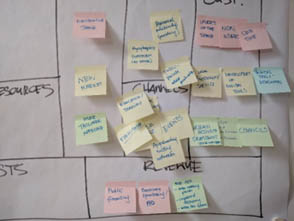Understanding the Exploitation Plan and Business Model in EU-funded Research Projects by Applying the Business Model Canvas Approach in Public Space
DOI:
https://doi.org/10.31522/p.31.1(65).8Keywords:
business model canvas, European research scheme, exploitation, public benefit-oriented projects, value propositionAbstract
European Commission has obliged Horizon 2020 and Horizon Europe beneficiaries to specify the dissemination and exploitation of their funded activities’ outcomes. In this way, research results can be extended to benefit the wider society. However, beneficiaries have difficulties meeting these goals due to the overlap between dissemination and exploitation and the uncertainty of how to translate research activities and outputs into socio-economic benefits for the society. This paper developed a framework based on the business model canvas to operationalise an approach to exploitation. The framework was tested within the EU-funded research project C3Places in the fields of urban planning and sustainable spatial development. The resulting reference framework can be used as a guideline for the design and development of research project exploitation plans. It is especially valuable for projects in the fields which usually do not have ‘sellable’ or even marketable outcomes and products but rather result in soft measures and recommendations for public policies. Accordingly, it can support the decision-making processes of both policymakers and private organisations.
References
Antunes, M.H. (2011) ‘Handbook for Dissemination, Exploitation and Sustainability of Educational Projects’. Lisbon: DiVa Consortium, p. 31.
Baden-Fuller, C. and Morgan, M.S. (2010) ‘Business models as models’, Long range planning, 43(2-3), pp. 156-171. Available at: https://doi.org/10.1016/j.lrp.2010.02.005.
C3Places - using ICT for co-creation of inclusive public places (no date). Available at: https://c3places.eu/.
Díaz-Díaz, R.; Muñoz, L. and Pérez-González, D. (2017) ‘The business model evaluation tool for smart cities: Application to SmartSantander use cases’, Energies, 10(3), p. 262. Available at: https://doi.org/10.3390/en10030262.
EC (European Commission) (2013) ‘Regulation (EU) No 1290/2013 Of The European Parliament and of the Council of 11 December 2013 laying down the Rules for Participation and Dissemination in “Horizon 2020 - the Framework Programme for Research and Innovation (2014- 2020)” and repealing Regu’, Official Journal of the European Union [Preprint]. Strasbourg.
EC (European Commission) (no date) Dissemination & Exploitation of results, HORIZON 2020 ONLINE MANUAL. Available at: https://ec.europa.eu/research/participants/docs/h2020funding-guide/grants/grantmanagement/dissemination-ofresults_en.htm# (Accessed: 3 March 2020).
European Commision (no date) Dissemination & Exploitation of results, Funding & tender portal. Available at: https://ec.europa.eu/research/participants/docs/h2020-fundingguide/grants/grant-management/dissemination-of-results_en.htm (Accessed: 3 January 2023).
European IPR Helpdesk (2015) ‘Fact Sheet: The Plan for the Exploitation and Dissemination of Results in Horizon 2020’, p. 11.
European Parliament (2021) Regulation (EU) 2021/695 of the European Parliament and of the Council of 28 April 2021 establishing Horizon Europe - the Framework Programme for Research and Innovation, laying down its rules for participation and dissemination, and repealing Regulations (EU) No 1290/2013 and (EU) No 1291/2013 (Text with EEA relevance), 2021/695, European Union, 13.10.10 (2021). Avaiable at: http://data.europa.eu/eli/reg/2021/695/oj
Gallego, M. et al. (2012) Deliverable D8.3: Business Model and Exploitation Plan.
Gasparin, M. et al. (2020) ‘Business as unusual: A business model for social innovation’, Journal of Business Research [Preprint]. Available at: https://doi.org/10.1016/j.jbusres.2020.01.034.
Kajanus, M. et al. (2019) ‘What can we learn from business models in the European forest sector: Exploring the key elements of new business model designs’, Forest Policy and Economics, 99, pp. 145-156. Available at: https://doi.org/10.1016/j.forpol.2018.04.005.
Osterwalder, A. and Pigneur, Y. (2010) Business model generation: a handbook for visionaries, game changers, and challengers. Johnn Wiley & Sons.
Osterwalder, A.; Pigneur, Y. and Tucci, C.L. (2005) ‘Clarifying business models: Origins, present, and future of the concept’, Communications of the association for Information Systems, 16(1), p. 1. Available at: https://doi.org/10.17705/1CAIS.01601.
Osterwalder, A.; Pigneur, Y.; Bernarda, G.; Smith, A. and Papadakos, T. (2014), Value proposition design: How to Create Products and Services Customers Want, Strategyzer series, Wiley, New Jersey. ISBN: 978-1-118-96805-5.
De Reuver, M.; Bouwman, H. and Haaker, T. (2013) ‘Business model roadmapping: A practical approach to come from an existing to a desired business model’, International Journal of Innovation Management, 17(01), p. 1340006. https://doi.org/10.1142/S1363919613400069
SIGMA ORIONIS (2015) Dissemination and Exploitation Plan & Communication Chart.
Skjævestad, F. and Bergheim, R. (2014) D 6.4 Exploitation Plan.
Strategyzer AG (no date a) How do I use the Value Propositions building block of the Business Model Canvas?, Using our Tools, Canvases & Methods. Available at: https://strategyzer.uservoice.com/knowledgebase/articles/1194370-how-do-i-use-the-value-propositions-building-block (Accessed: 5 March 2020).
Strategyzer AG (no date b) Value Proposition Canvas. Available at: https://www.strategyzer.com/canvas/value-proposition-canvas (Accessed: 5 March 2020).
Sustainability & Exploitation plan & monitoring: WP8 _ deliverable 8.1 (2017).
Tanda, A. and De Marco, A. (2019) ‘Business Model Framework for Smart City Mobility Projects’. In: IOP Conference Series: Materials Science and Engineering. IOP Publishing, p. 92082. Available at: https://doi.org/10.1088/1757-899X/471/9/092082.
Vertical Green 2.0 (2018) JPI Urban Europe. Available at: https://jpiurbaneurope.eu/project/vertical-green-2-0/ (Accessed: 17 April 2023).
Žlender, V. and Šuklje Erjavec, I. (2020) Exploitation plan: Using ICT for Co-Creation of Inclusive Public Places, p. 32. Available at: https://c3places.eu/sites/default/files/pagefiles/C3Places_D6.3_ExploitationPlan_Sep20.pdf (Accessed: 3 January 2023).
Žlender, V.; Šuklje Erjavec, I. and Goličnik Marušić, B. (2021) ‘Digitally Supported Co-creation within Public Open Space Development Process: Experiences from the C3Places Project and Potential for Future Urban Practice’, Planning Practice & Research, 36(3), pp. 247-267. Available at: https://doi.org/10.1080/02697459.2020.1829286.

Downloads
Published
How to Cite
Issue
Section
License
Copyright (c) 2023 Vita Žlender, Ina Šuklje Erjavec

This work is licensed under a Creative Commons Attribution 4.0 International License.
Copyright (c) 2021 authors and journal.
This work is licensed under a Creative Commons Attribution 4.0 International License.
Authors who publish with this journal agree to the following terms:
In agreeing this form, you certify that:
- You read the ethical codex of the PROSTOR available at journal web.
- You submitted work is your original work, and has not previously been published and does not include any form of plagiarism.
- You own copyright in the submitted work, and are therefore permitted to assign the licence to publish to PROSTOR.
- Your submitted work contains no violation of any existing copyright or other third party right or any material of an obscene, libellous or otherwise unlawful nature.
- You have obtained permission for and acknowledged the source of any illustrations, diagrams or other material included in the work of which you are not the copyright owner.
- You have taken due care to ensure the accuracy of the work, and that, to the best of your knowledge, there are no false statements made within it.
- All co-authors of this submitted work are aware of, and in agreement with, the terms of this licence and that the submitted manuscript has been approved by these authors.






